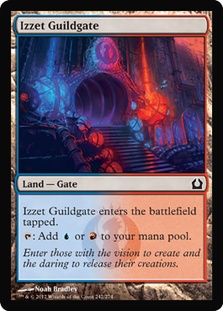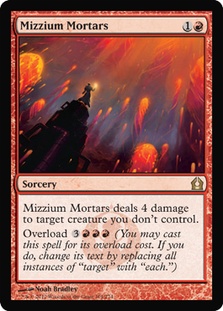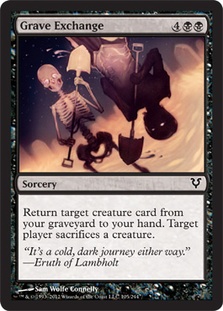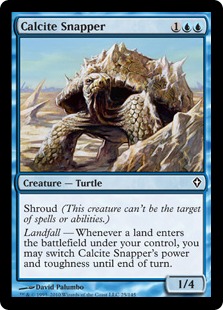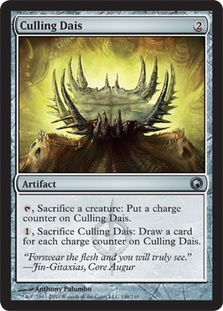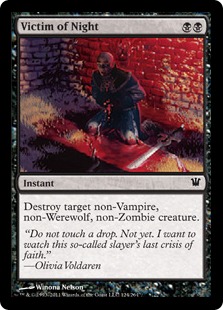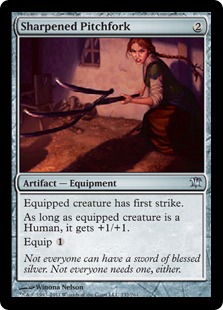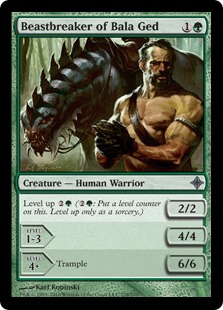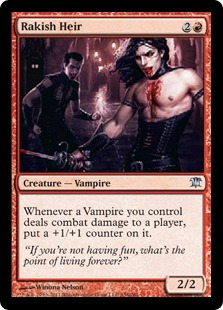Every Magic block brings at least one artist the game hasn’t seen before. It’s in the nature of freelance work: the artist-commissioner relationship breaks down one way or another, and a new one forms. I’ve had my eye on a number of artists who’ve made their Magic debuts recently (counting Standard-legal sets as "recently") and are leaving their marks on the game—and in some cases, on the wider world of illustration art. I mentioned a few new artists briefly in past articles (such as my Magic 2013 flavor review), but today I’m looking at three of them in more detail.
Noah Bradley
Technically Noah Bradley made his Magic debut with the Magic Online Cube, where his earliest assignments were alternate illustrations for Plateau and Volcanic Island, but he started in paper with a trio of basic land illustrations and Spelltwine for Magic 2013. The basic lands made my inner art geek do a happy dance, but Spelltwine left me uneasy about whether he’d be a good fit for anything but landscapes in Magic art.
Return to Ravnica put that concern to rest. Giant Growth is quality, Mizzium Mortars is dazzling, and the lands are as amazing as ever.
"These pay my bills, bills, bills…"
In a larger sense, though, Mr. Bradley isn’t just looking to make awesome illustrations. Through aggressive entrepreneurship, he’s aiming to change the business of illustration art.
Mr. Bradley’s business practices are, in a word, polarizing.He has zero patience for any lingering remnants of the art and commerce divide; his Twitter biography, for example, reads: "Artist. Not the unemployed kind." In a recent blog post, "Fake it," he describes how he went after the art business aggressively, building himself up as a brand far ahead of the usual freelancer’s schedule.
He doesn’t just sell the usual array of artist’s proofs and prints; he also sells his expertise through recorded lectures and a mentorship program. He goes far above the usual price structure at $12 for Izzet Guildgate and $27 for Mizzium Mortars, though to be fair, he does include free shipping on his online orders. Speaking of prices being higher than normal, he’s also dedicated a blog post to the principle: "Charge more."
He’s an artist-capitalist, and that’s why a lot of people seem to dislike him. (There’s an "Elitist Artist Noah" meme floating around the Internet, and yes, he knows about it.) That’s somewhat the point with Mr. Bradley, though; he’s not inclined to "wait his turn" or "pay his dues" or any of the other trite phrases about starting as a freelance artist. He has his prices, he will charge them, and if you don’t like them, you can say no and walk away.
If he wants to paint while listening to Halley’s Fifth Concerto, it doesn’t bother me any. As for his original illustrations, I’m content to pass for now. He wants a cool $2,000 for his original Magic paintings, and even though they’re much larger than the usual Magic illustration, I remember Ryan Pancoast’s gorgeous Plains of similar size being offered for $850. So I’ll sit back and watch. Either his work sells at the $2,000 price point, creating a precedent for his original illustration art market that freezes me out, or he’ll find that his work doesn’t sell at that level and lower his prices.
In the fine art world, there are superstar artists and lesser-tier names. Opinions of who is where shift constantly, and an artist who seems on top of the world can find himself or herself tumbling without warning. Back in the early 1980s, before Mr. Bradley was born, a bloke named Julian Schnabel was breaking plates, selling out shows, and swaggering his way through the global art scene. My generation knows him better as a director for films such as The Diving Bell and the Butterfly and Basquiat, the latter a biopic about an artistic cautionary tale who died at 27.
Will Mr. Bradley become the Julian Schnabel of illustration art or will he lock down a place in the pantheon like Frank Frazetta, creator of the iconic Death Dealer? Either way, he’s absolutely an artist to watch. If you’re attending the SCG Open Series event in Baltimore at the start of December, check out his booth, and if you have the money, buy a sketch on the back of an artist’s proof. Sketches are some of the best ways to get original work from Magic artists, and from what I’ve seen of Mr. Bradley’s sketches, even at $42 for a sketch on the back of a less-expensive proof you’ll get your money’s worth.
Sam Wolfe Connelly
I had high hopes for the "Wolfe in sheep’s clothing" when I learned he was doing Magic cards, but the payoff wasn’t what I expected. After three cards in Avacyn Restored—Cursebreak, Grave Exchange, and Otherworld Atlas—he hasn’t done anything else for the game that we’ve seen, though according to a July 30 post on his Tumblr account, he suggested there was more Magic illustration on the way.
Even with the slightly underwhelming debut, I’m a fan of most of Mr. Connelly’s work, and I’m excited to see what he does next for Magic. (Content caution: Mr. Connelly’s non-Magic work includes tasteful nude illustrations which make his main website and Tumblr account potentially not safe for work, hence the lack of general linkage. For completely work safe samples, see "Fox in Socks" and "Bleary Night.")
Before Mr. Connelly revealed that he was doing further work for Magic, I was worried because in some ways he’s an odd fit with the game. As a "pencil" (technically graphite-carbon) illustrator, his work tends toward the monochrome with color as a light touch—quite at odds with the prevailing "saturated" style of most Magic illustration these days. He isn’t strictly analog, as he’s done digital editing for certain commissions, but again he’s seemingly out-of-step with the broader trends. Even so, talent is talent, and every time I think about his work, I edge closer to pulling out my wallet and swapping a little piece of his soul for some of my cash.
My biggest concern regarding Mr. Connelly’s future with Magic is whether he’ll be able to adapt to the teeny-tiny space that is a Magic card’s illustration box. It’s an adjustment every successful Magic artist has to make. While Otherworld Atlas looks fine (albeit not like Mr. Connelly’s other work) and I’m an unabashed fan of Cursebreak, Grave Exchange feels small and tinny at card size, like a college rock station on a cheap radio.
"Is that a…mandolin I’m hearing?"
I have high hopes that he’ll make the transition, though, and I’m curious where he’ll go next. He’s young (only 24, so younger than I am…suddenly I feel old) with a certainty and maturity about him. I’m looking forward to enjoying his work for a long time to come.
Winona Nelson
Ms. Nelson is the last (though by no means least) Magic artist I’ll cover today. A character designer gone freelance, she’s a technically gifted and expressive artist with plenty to offer Magic. She also happens to be plugged into one of the most famous families of fantasy art, the Vallejo – Bell – Palumbo group, though I’m unsure of the exact relationship between her and Anthony Palumbo, the older Palumbo brother. (Ms. Nelson and Mr. Palumbo "live and work together" and share a cat, so there’s that.)
Of the Palumbo generation, younger brother David was the first to illustrate Magic cards, debuting in Worldwake with Apex Hawks and Calcite Snapper. Anthony followed with Contagion Clasp and Culling Dais in Scars of Mirrodin, his first Magic set. Winona Nelson started with Innistrad and has contributed at least one new piece of art to every set since.
What I like most about Ms. Nelson’s presence in Magic art (aside from her abundant technical skill) is that she’s doing her part to redefine the body types represented in the game. She does "busty angels" as well as any artist—there’s more than a little Vallejo in Bruna, Light of Alabaster—but the women she presents for the game are far from one-note.
Take a look at Sharpened Pitchfork, for example. In the hands of many artists, and not just male artists, this scene might have turned into something straight out of a bodice-ripping romance novel cover from the 1970s (think Lingering Souls and Night Terrors). As Ms. Nelson painted her, though, the wielder of the Sharpened Pitchfork isn’t sexualized at all. She’s simply an ordinary woman of Innistrad using the one tool at her disposal to fend off the threats menacing her—a real woman, not a half-dressed Barbie doll.
"I’m a real…live…woman…"
Ms. Nelson also varies the male characters she depicts. She’s quite capable of creating a Conanesque male physique, but so far her Magic men have been of athletic yet regular or slim build, not Beastbreaker of Bala Ged clones. The Victim of Night matches that description under his robe, while certain of her vampires have left considerably less to the imagination; Magic’s chief Art Director, Jeremy Jarvis, memorably singled out Ms. Nelson’s Rakish Heir as "guy candy." The Rakish Heir’s corset-and-pectorals look has a clear connection to Ramsey, the cyborg protagonist of Ms. Nelson’s comic story Cassiopeia.
"Move over, buff stuff. There’s a new body image in town."
Like any other depiction of the human form, women like Sharpened Pitchfork’s auburn-haired lass or men like the Rakish Heir can become boring if overused, but for now they serve as valuable counterpoints to the dominant body types in Magic. Now if I could find a fat Magic character who isn’t evil or comic relief, I’d be set…
Who Are Your New Artists to Watch?
There are many other artists with recent Magic debuts, including Christine Choi, Seb McKinnon, Cynthia Sheppard, and Jack Wang. Who are your new favorite artists and why? Let me know in the comments.
As always, thanks for reading.
— JDB
@jdbeety on Twitter


